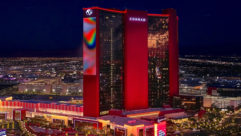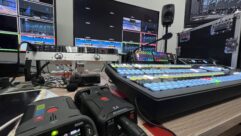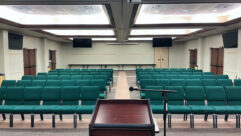
Conference Center Connects with QSC Q-Sys Integrated System Platform, Part 2
Jan 22, 2013 11:38 AM,
With Bennett Liles
Listen to the Podcasts

Editor’s note: For your convenience, this transcription of the podcast includes timestamps. If you are listening to the podcast and reading its accompanying transcription, you can use the timestamps to jump to any part of the audio podcast by simply dragging the slider on the podcast to the time indicated in the transcription.
The Sheraton Fairplex Conference Center has thousands of square feet of ballrooms and meeting space, and they had to have it all connected for video and sound. Rick Shaw from CSI Multimedia is back to wrap up his account on how it all got set up and done, coming right up on the SVC Podcast.
SVC: Rick Shaw, thanks for being back with us for part two on the SVC Podcast from CSI Multimedia.
A pleasure.
Out there in Woodland Hills, Calif., and we were talking about this huge project at the Sheraton Fairplex Conference Center. They did a big addition to that already huge place and we mentioned the QSC QSys and the Core 4000, how you set up infrared sensing for the air walls in the rooms, basically making things easier for the onsite people to adapt the place to suit any client’s requirements. How does the Core 4000 communicate with the Powerlite 3 PL-340 amps that you used on this?
The amps are equipped with a data port. There are two levels of QSC amps, which are equipped in such a way and by connecting the I/O frame digitally into the amplifier we get enormous amounts of information back from the amplifier—temperature, wattage, temperature of the wires. We can tell if a DJ is being bad and heating up the system. So we know why the clip went off or why it protected itself. We can go back and look at the data and say, “Well, this side of the amp was this hot and here’s the input—here’s what was feeding it.” So it enables us in realtime to evaluate the whole system. We have remote GUIs, and you can use an iPad or in the case of Fairplex, we have these big 70in. screens that they use as whiteboards and videoscreens in the individual media rooms. And we can call up our program on any one of those and we can train off of it and we can see where the loads are going and what the temperature the core itself is and how many cycles it’s running. So we can, in realtime, watch the loads throughout the building and see if somebody ask, “Do you have room for expansion?” We can say, “Well, yeah, we’re at 80 percent in this area, core is running at 60 percent; we’ve got 20 percent that you could use and it usually just boils down to adding more I/O frames. [Timestamp: 2:50]
And with a place that big and capable of so many different configurations in the meeting areas, you would have to be able to operate it from just about anywhere.
Yes, absolutely and we have a pinhole. My engineer can sit in his living room and control the whole building and with the listening mics he can get actual realtime feedback as to what the volumes in the room are, what the EQ sounds like, and he can even, if he wants to, turn on one of the microphones and listen. [Timestamp: 3:16]
And a huge number of speakers you installed. I guess they’re mostly ceiling speakers. What speakers did you decide to go with in the meeting rooms and the ballrooms?
Well, we have 240 speakers in the building and primarily the main ballrooms are handled by Cloud 12 from Community. Community Professional loudspeakers just make the finest speakers in the world in the areas that they are focused. And this is one of the places that they excel, and then because the main hall is so high, we needed a really long throw speaker, but it had to be narrow enough to fit in the well and we found that out of Italy with RCF. They’re part of dB Technologies and they make this extremely high powered speaker that’s very, very small and compact—sounds wonderful and then we used their Cloud 6s, which is their small one for the meeting rooms and the bathrooms. [Timestamp: 4:09]
Conference Center Connects with QSC Q-Sys Integrated System Platform, Part 2
Jan 22, 2013 11:38 AM,
With Bennett Liles
Alright and you have some additions that are coming up so what are your plans for the system expansion?
Yeah, we expanded into building 8, which is the building that’s attached to it, and we had done one building with a very high performance sound system, and the problem was that the buildings are just cement blocks. They were tank factories when they were built, so these big huge cement rooms and we never did any sound abatement in building 9. So we’ve been scaling down how we do the sound and now Community has just come out with this wonderful architectural sconce speakers. It’s a dual six and so we’re going to use that in the walls in building 5 and if that works we’ll probably do the other three 40,000 sq. ft. buildings and then on to attack the monster 105,000 sq. ft. main hall number 4 for anybody that’s ever been to the fair. And once we get the rooms done, it’s like painting a battleship. We’ll probably have to go back and start at the finish line where we installed 107 television sets, so it’s about time for them to be breaking down and needing replacements. [Timestamp: 5:22]
Well it sounds like you’ve got your work cut out for you. I understand that you’ve also got all of this configured to work an emergency system in the Conference Center. How did you do that?
It’s really very cool. We just get a trigger signal from the emergency system, and there is an emergency status for the Core 4000. The way that works is it can either just mute everything or it can mute everything and start playing an emergency recorded message and it can do that anywhere. So in one part of the building you can have the recorded message and the other part it can just be muted. [Timestamp: 5:55]
And that could be a very big deal because when that place is full of people it could take a while to get everybody out of there. Right, especially if all you hear is the fire alarms going off. We’re all a little bit, I guess, jaded about that. Some people don’t react right away if there is no smoke, and we have one recorded message that says please exit the building in an orderly fashion. It sounds like a high school thing, but that really makes sense because it’s calm sounding voice and if you’ve got those ballrooms full of people and the fire alarm goes off you’ve got a stampede on your hands. [Timestamp: 6:27]
Yeah, I can imagine and with that many different types of events you never know what the disposition of the crowd’s going to be like.
Yeah.
You’re going to have to accommodate new sources and expansions, so how can the system be upgraded?
Well one of the wonderful things, again one of the reasons we chose the QSys is the cores talk to each other. Now the Core 4000 is our biggest one, but they go all the way down to a 500, which basically doesn’t use I/O frames. Everything’s just built right into it. You get six cards, so for an outlying building you might want to choose that and just let it be independent in the building while it’s still communicating with the main system or as we did in building 8, just put an I/O frame in there and let it talk to the Core 4000. But you can put multiple cores in. In fact one of the configurations that we discussed was a dual core system where you would have redundancy and they’re designed to do that so they both are working all the time and if one fails the other one just automatically keeps going. No lag time so you can add another 4000 into the grandstands and one over at the other end of the park and eventually it’s going to be all one sound web. [Timestamp: 7:39]
So when you got everything in and the wiring run and it was powered up, how was programming and testing the whole system?
Well AV’s the last tray in the building except for maybe flower arrangements. We have one week to initiate the system and test it, and during that week they had two events, so fortunately, thanks to the quality of the machines, we had one bent wire on a connector from one of the I/O’s. We had one amplifier that arrived a little wonky and QSC just sent a replacement immediately—not even change out they just the piece as soon as they heard. Other than that, the grand opening we had the main speaker throughout the building, all of the video images flawlessly—nothing at all was a problem just amazed me. [Timestamp: 8:29]
Did you have to do any sort of substantial training for the local tech people? It sounds like the system almost works itself.
It does. The Fairplex has a rental AV company that is onsite that does all of their rental stuff, so we train them and the hotel staff. The beauty of using those 70 in. screens is our whole system comes up on the screen and the alert systems are all color-coded, so you look at the screen. Immediately if you don’t see green everywhere, you know there’s something that has to be dealt with. They were able to learn and see it all in realtime, and we could simulate a problem and it would come up on the screen and they could see how to fix it. So training, we probably put about 6-8 hours into each class and we taught four classes. [Timestamp: 9:13]
And I would think that there are some unique differences about setting up a system like this for a conference center as opposed to a performance venue or a classroom environment.
Yeah, the problems are more unique. You do a school or church or night club, you don’t have to be as flexible, but when it’s a training conference center, it’s not like only one company at a time rents out the Fairplex. In fact, in our first week we had medical training seminar, which I told you about earlier where there was actually two doctors that had the remote surgeries and they required a ton of extra bandwidth for remote videoconferencing and teleconferencing and to check on their patients and then at the same time we had a tradeshow with all corporate hands on meeting going on at the same time for Armstrong Nurseries. And then we had a breakout for one of the auto makers and I think a beer company, and of course one turns it into a bar and another turns it into trade floor and the doctor’s turned it into high-tech—everybody had their tablets teleconferencing. [Timestamp: 10:25]
Well, it sounds like there’s so much going on there that the system would have to be highly automated and putting one in on that scale was a substantial job. Thanks Rick for taking the time to give us all a quick look at what you did on this one and Rick Shaw from CSI Multimedia in Woodland Hills, Calif., and the Sheraton Fairplex Conference Center. Sounds like it went pretty well.
Yeah, it was very fortunate but as my engineer says execution is everything so. Well, thank you for your time it was a pleasure. I really enjoyed it. [Timestamp: 10:56]










